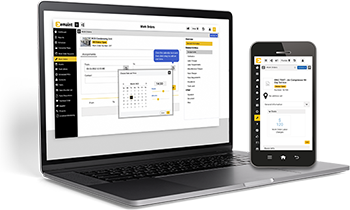
Preventive maintenance is a proactive strategy that relies on scheduled maintenance activities with the goal of keeping assets in good working order and extending asset life. Unlike reactive maintenance approaches like run-to-failure, preventive maintenance aims to identify and resolve problems before they become serious.
Preventive maintenance has many advantages, including reducing downtime and increasing productivity by keeping your assets on-line for longer. But the approach can also be expensive, in terms of labor, time, and parts.
We’ll take a look at some of the disadvantages of preventive maintenance and discuss alternatives, like predictive maintenance and condition monitoring.
What Is Preventive Maintenance?
Preventive maintenance is a highly structured approach to maintaining your equipment. It involves servicing all of your assets on a scheduled basis, instead of waiting until they need repair. Preventive maintenance can be either calendar-based or usage based.
Calendar-based preventive maintenance means that your maintenance teams will clean and lubricate parts, replace components, and perform other routine upkeep at regular scheduled intervals, like every week or month.
Usage-based preventive maintenance means that once an asset has reached a certain milestone (i.e. a certain number of hours of operation), it will be repaired, serviced, or replaced.
This is similar to preventive maintenance for consumer vehicles, where the oil is changed every year and/or when a certain number of miles have been driven.
What are the Advantages of Preventive Maintenance?
Preventive maintenance ensures that your assets always stay in optimal running condition. When your belts and valves are changed on a schedule, you’re likely to experience fewer slow-downs due to worn-out parts. Done well, preventive maintenance management can help you reduce unplanned downtime and can help you avoid getting stuck in reactive mode, where you’re constantly putting out fires.
What are the Disadvantages of Preventive Maintenance?
Preventive maintenance can spare your operation unplanned downtime, and it can keep your machines in excellent working condition; however, it’s not a perfect science. That’s why more operations are shifting to a predictive maintenance approach that allows you to use real-time data to determine your machines’ maintenance requirements.
Here are some of the major disadvantages of preventive maintenance:
1. It involves extensive planned downtime
You need to schedule frequent shutdowns to give your maintenance team access to equipment, so that they can perform routine cleaning and repairs. Because shutdowns are based on a time- or usage-driven schedule, machines are taken offline for maintenance whether or not they actually require any repairs. This is great for getting ahead of potential issues, but when every minute of downtime is costly, shutting down equipment unnecessarily is not ideal.
2. It can be expensive
Your maintenance team will be changing parts and performing minor repairs on a regular basis, even when your equipment is already in optimal condition. This results in high costs, both in terms of labor and materials. Plus, you’ll need to keep a lot of extra supplies on-hand, increasing costs and taking up valuable warehouse space.
3. It isn’t tailored to your plant’s needs
Preventive maintenance follows industry guidelines and standards for maintaining equipment. But those standards might not apply to the realities of conditions in your plant. Temperature, air quality, and other operating conditions can impact the lifecycle of all your assets. Preventive maintenance doesn’t take these real-world conditions into account. Without additional data to support your maintenance timelines, you could end up performing unnecessary maintenance and you risk missing defects that can occur between scheduled maintenance visits.
What is Predictive Maintenance?
Predictive maintenance is a proactive strategy that harnesses the power of Industrial Internet of Things (IIoT) technology and condition monitoring to keep your assets up and running for longer. Maintenance teams that practice predictive maintenance use asset data to identify new faults as soon as they appear.
IIoT sensors can collect data on vibration levels, temperature, and other key indicators of asset health. Data analytics software analyzes that data in real-time, and can alert you as soon as your equipment shows signs of a defect. This means that your maintenance teams can identity and fix the issue right away – before it turns into a major problem.
Instead of performing maintenance tasks according to a schedule, predictive maintenance uses data analytics to pinpoint exactly when and where you need to focus your maintenance efforts. Because of this, condition monitoring and predictive maintenance can drastically cut down on maintenance costs. This approach also makes it possible to operate with a smaller workforce, or with fewer skilled maintenance workers.
Predictive maintenance doesn’t suffer from the critical disadvantages of preventive maintenance. Maintenance is performed on the right asset at the right time, saving you time and money on maintenance and corresponding asset downtime.
Choosing the Right Maintenance Strategy
There is no one-size fits all maintenance solution.
For most operations, a mixture of predictive maintenance and preventive maintenance is key to keeping your assets running smoothly and to maximizing uptime. Predictive maintenance counters the disadvantages of preventive maintenance, but it doesn’t mean the two strategies can’t work in harmony.
If you’re interested in trying out a predictive maintenance strategy, start by testing out that approach on a few of your assets. Doing a test-run keeps your initial costs low and enables you to prove the value of predictive maintenance before scaling the approach across all of your assets.


